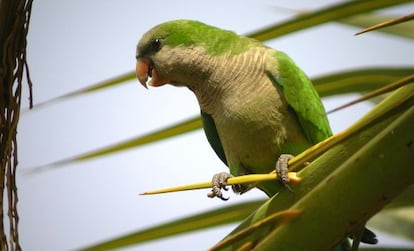Monk parakeets now seen as a plague in major Spanish cities
Some 20,000 birds have been counted across Spain by one ornithologist group


They were first detected in Spain in 1975, but now they have become a major environmental problem.
For the first time, Spain has seen a spike in the number of monk parakeets in urban areas. According to a survey conducted by 600 volunteers from the ornithologist group SEO/Birdlife, there are now some 20,000 of these exotic bright green birds flying free in some 450 Spanish cities.
You’ll need to spend a lot of public money to eliminate them” Juan Carlos del Moral, SEO/Birdlife
Madrid and Barcelona are the two urban centers where most monk parakeets have been detected. In the Spanish capital alone, volunteers counted 2,091 nests, putting their numbers between 5,875 and 6,643. Barcelona is also estimated to have between 5,525 and 6,248 monk parakeets.
“Of all the birds brought here, it is probably the species that has grown most in numbers,” said Juan Carlos del Moral, coordinator for SEO/Birdlife’s area of study and follow-up on birds.
And much of the problem originated with people who brought the monk parakeets to Europe as pets. They were first detected in 1975 in Barcelona, but they gradually spread within 10 years.
Despite the problem, ornithologists prefer to classify them as an introduced species rather than an invasive one.
Native to the subtropical zones of Argentina, the monk parakeet (Myiopsitta monachus) has adapted well in similar climates found in Andalusia, Valencia and Murcia.
“These birds are not migratory but are pretty much sedentary,” explained Del Morral, adding that their expansion across the Iberian Peninsula didn’t originate from one grouping.
The noisy birds have grown in numbers because they have accidentally gotten loose from their cages or intentionally released by bird owners. In 2013, the monk parakeet – popularly known as the “Argentinean parrot” in Spanish – was included in the list of species prohibited by law.
“They are highly visible because they adapt well in urban areas,” Del Moral explained. “The problem now are the numbers that they have reached – in Madrid alone there are more than 2,000 nests and 200 breeding points.”
But there are practically no “efficient eradication” efforts being carried out by authorities to reduce their populations.
“Now the problem has gotten out of hand and you’ll need to spend a lot of public money to eliminate them,” he said.
Even though they may look attractive, Del Moral said this exotic bird has caused “a negative impact on Spain’s natural fauna and flora.” For example, they have disturbed the nests of other birds, and have been blamed for “drying up trees” because they eat their sprouts.
English version by Martin Delfín
Tu suscripción se está usando en otro dispositivo
¿Quieres añadir otro usuario a tu suscripción?
Si continúas leyendo en este dispositivo, no se podrá leer en el otro.
FlechaTu suscripción se está usando en otro dispositivo y solo puedes acceder a EL PAÍS desde un dispositivo a la vez.
Si quieres compartir tu cuenta, cambia tu suscripción a la modalidad Premium, así podrás añadir otro usuario. Cada uno accederá con su propia cuenta de email, lo que os permitirá personalizar vuestra experiencia en EL PAÍS.
¿Tienes una suscripción de empresa? Accede aquí para contratar más cuentas.
En el caso de no saber quién está usando tu cuenta, te recomendamos cambiar tu contraseña aquí.
Si decides continuar compartiendo tu cuenta, este mensaje se mostrará en tu dispositivo y en el de la otra persona que está usando tu cuenta de forma indefinida, afectando a tu experiencia de lectura. Puedes consultar aquí los términos y condiciones de la suscripción digital.
Últimas noticias
Maduro pleads not guilty before the federal court in New York: ‘I am still the president of Venezuela’
A new test can detect Alzheimer’s from a finger prick
UN team enters Sudanese city of El Fasher after paramilitary massacre: ‘It’s like a ghost town’
A recipe for resistance: Indigenous peoples politicize their struggles from the kitchen
Most viewed
- Gilles Lipovetsky: ‘If you want to live better and fall in love, take Prozac, don’t look to philosophy’
- Alain Aspect, Nobel laureate in physics: ‘Einstein was so smart that he would have had to recognize quantum entanglement’
- Alvin Hellerstein, a 92-year-old judge appointed by Bill Clinton, to preside over Maduro’s trial in New York
- Maduro’s downfall puts China’s relationship with Venezuela to the test
- Why oil has been at the center of Venezuela-US conflicts for decades








































